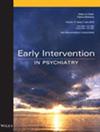Family history is amongst the most significant risk factors for psychotic and bipolar disorders. Despite being clearly defined, easily and early identifiable, familial high-risk status is minimally accounted for in mainstream prevention paradigms. This study reports on the demographics and clinical characteristics of youth with a first-degree relative affected by psychotic or bipolar disorders within a large academic healthcare system.
In this quality improvement study, using electronic medical records, the authors examined demographics, psychiatric and medical diagnoses, substance use, service utilisation, and psychotropic medication use in children, adolescents and young adults (age 24 or younger) with and without a family history of psychotic or bipolar disorders within the Mass General Brigham (MGB) healthcare system.
Family history-positive (FHP) youth demonstrated markedly higher rates of psychiatric problems (57.8%) compared to family history-negative (FHN) youth (8.5%), including higher rates of psychotic and bipolar disorders, as well as anxiety disorders and depression. FHP youth also had more frequent psychotropic medication use and medical problems. Additionally, FHP youth reported higher cannabis and alcohol use, along with higher rates of suicidal ideation and trauma. Despite this, only 4% of FHP youth visited an MGB psychiatry or psychology department within the six months preceding the analysis.
FHP youth constitute a distinct and practically identifiable risk cohort within a large academic healthcare system. Increased psychiatric and medical problems coupled with more prevalent risk factors amongst familial high-risk youth highlight the need for tailored clinical programmes to achieve both primary and secondary prevention.


